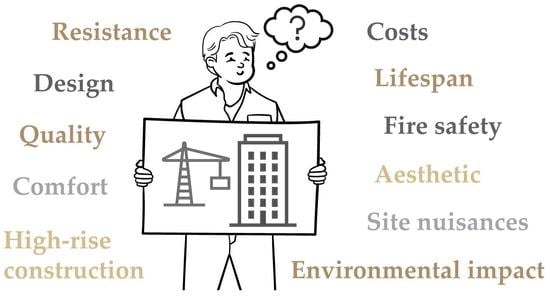Social Representations of Mass Timber and Prefabricated Light-Frame Wood Construction for Multi-Story Housing: The Vision of Users in Quebec
Abstract
1. Introduction
2. Materials and Methods
2.1. Content of the Questionnaire
2.2. External Validity and Socio-Demographic Characterization of the Sample
2.3. Data Analysis
3. Results
3.1. Representations Associated with Wood Construction Methods
3.1.1. Representations Associated with the Main Structural Materials
3.1.2. Representations Associated with Mass Timber Construction
3.1.3. Representations Associated with Prefabricated Light-Frame Wood Construction
3.2. Response Profiles
3.2.1. Global Response Profile
3.2.2. Multi-Factorial Analysis Response Profiles
3.2.3. Profile of Responses Related to Respondents’ Characteristics
Type of Housing Structure
Respondent’s Gender
Respondent’s Age
- For preference and design, on the variety of the design in prefabrication, individuals 18 to 24 years old have a neutral perception, while individuals over 65 years old possess a positive perception.
- For the environmental impact, the reduction of construction waste is perceived neutrally by individuals 35 to 44 years old, negatively by individuals 55 to 65 years old, and positively by individuals over 65 years old. Regarding the reduction of environmental impact, individuals 18 to 24 years old and individuals 55 to 65 years old take a neutral position, while individuals over 65 year old have a positive perception of this construction technique.
- For quality, the fact that prefabrication is affordable is perceived neutrally by individuals 35 to 44 years old and individuals over 55 years old. Factory construction is a definition of prefabrication that is not shared by individuals 45 to 54 years old, while it is approved by individuals over 65 years old. The fact that prefabrication increases construction quality is viewed negatively by individuals 25 to 34 years old, neutrally by individuals 55 to 65 years old, and positively by individuals over 65 years old. Whether prefabrication is synonymous with high quality is perceived neutrally by individuals 25 to 34 years old and individuals 55 to 65 years old, negatively by individuals 45 to 54 years old, and positively by individuals over 65 years old. Finally, with regard to the preference of construction methods in relation to quality, individuals 18 to 24 years old are neutral, individuals 25 to 34 years old position themselves negatively, and individuals over 65 years old position themselves positively towards prefabrication.
- For safety, on the preference of the construction methods according to the structural resistance, individuals 25 to 34 years old and individuals over 55 years old are neutral, while the individuals 35 to 44 years old position themselves negatively towards prefabrication.
- For the advantages relative to the construction site, more specifically on reduction of construction time, individuals 25 to 34 years old and individuals 45 to 54 years old express a neutral perception, while the individuals over 55 years old express a negative perception.
4. Discussion
4.1. Representations Associated with Wood Construction Methods
4.1.1. Representations Associated with the Main Structural Materials and Mass Timber Construction
4.1.2. Representations Associated with a Prefabricated Light-Frame Wood Construction
4.2. Response Profiles
4.2.1. Global Response Profile
4.2.2. Multi-Factorial Analysis Response Profile
- Totally favorable whatever the wood construction method;
- Totally unfavorable regardless of the type of wood construction;
- Partially favorable to neutral towards mass timber construction and prefabrication;
- Partially favorable for mass timber and wood light-frame but unfavorable for prefabrication;
- Divided on prefabrication.
4.2.3. Profile of Responses Related to Respondents’ Characteristics
Type of Housing Structure
Respondent’s Gender
Respondent’s Age
5. Conclusions
Author Contributions
Funding
Institutional Review Board Statement
Informed Consent Statement
Data Availability Statement
Acknowledgments
Conflicts of Interest
Appendix A
| Variable Wording | Question | Subquestion | Items |
|---|---|---|---|
| Obtaining consent from respondents | |||
| 1. Gender | You are: | A man A woman Non-binary | |
| 2. Age | How old are you? | Under 18 years old 18–24 years old 25–34 years old 35–44 years old 45–54 years old 55–65 years old 65 years and older | |
| 3. Region of residence | In which region of Quebec do you live? | Abitibi-Témiscamingue Bas Saint-Laurent Capitale-Nationale Centre du Québec Chaudière-Appalaches Côte-Nord Estrie Gaspésie-Îles de la Madeleine Lanaudière Laurentides Laval Mauricie Montérégie Montréal Nord-du-Québec Outaouais Saguenay-Lac Saint-Jean | |
| 4. City of residence | In which city? | open answer | |
| The structural materials (shown in the images below) support the building and provide solidity to resist time, loads, and weather. At the end of construction, they are often no longer visible, hidden by the finishing materials. | |||
| PICTURE NOT AVAILABLE FOR COPYRIGHT REASONS Steel building | PICTURE NOT AVAILABLE FOR COPYRIGHT REASONS Concrete building | PICTURE NOT AVAILABLE FOR COPYRIGHT REASONS Mass timber building | PICTURE NOT AVAILABLE FOR COPYRIGHT REASONS Light-frame wood building |
| 5. Positive building preference | Which of these buildings would you most like to live in? | Steel building Concrete building Mass timber building Light-frame wood building | |
| 5.1. Reason for positive building preference | For what reason(s)? | Acoustic comfort Thermal comfort Durability Aesthetics of the material Quality of construction Safety Solidity Other: open answer | |
| 6. Negative building preference | Which of these buildings would you least like to live in? | Steel building Concrete building Mass timber building Light-frame wood building | |
| 6.1. Reason for negative building preference | For what reason(s)? | Acoustic comfort Thermal comfort Durability Aesthetics of the material Quality of construction Safety Solidity Other: open answer | |
| 7.1. S Lifespan 7.2. C Lifespan 7.3. MT Lifespan 7.4. WLF Lifespan | In your opinion, what is the average lifespan of a building constructed in: | Steel Concrete Mass timber wood light-frame | 20 years or less 40 years 60 years 80 years 100 years and more |
| 8. Eco-friendly materials | What do you think are the most environmentally friendly structural materials for multi-story housing construction? | Steel Concrete Mass timber wood light-frame | |
| 9. Acoustic comfort | What materials do you think provide the best acoustic comfort? | Steel Concrete Mass timber wood light-frame | |
| 10. Thermal comfort | What materials do you think provide the best thermal comfort? | Steel Concrete Mass timber wood light-frame | |
| 11. High-end materials | In a multi-story housing, what structural materials do you consider high-end? | Steel Concrete Mass timber wood light-frame | |
| 12.1. Exposed S 12.2. Exposed C 12.3. Exposed MT 12.4. Exposed WLF | Would you leave these structural materials visible in your residence? | Steel Concrete Mass timber wood light-frame | Not at all Rather not It depends Rather yes Very much so |
| 13.1. MT fire safety | Regarding mass timber construction, do you agree with the following statements? | Mass timber construction performs as well as concrete in the event of fire. | Totally disagree Disagree It depends Agree Totally agree |
| 13.2. MT deterioration | Very often, mass timber structures do not age well (cracks, swelling, moisture, mold, termites, etc.). | ||
| 13.3. MT structural strength | A building built with mass timber is less resistant than buildings built with other materials. | ||
| 13.4. MT structural deformation | A mass timber structure deforms over time. | ||
| 13.5. Exposed MT degradation | A visible wood structure degrades rapidly over time. | ||
| 13.6. MT maintenance | A wooden structure requires more maintenance than a concrete structure. | ||
| 13.7. MT construction cost | For multi-story housings, mass timber is more expensive than concrete. | ||
| 13.8. MT insurance cost | When living in a mass timber building, insurance costs are higher. | ||
| 13.9. MT chemical treatment | Mass timber contains many chemicals. | ||
| 13.10. Deforestation | The use of wood in construction leads to deforestation. | ||
| 13.11. Biodiversity damage | The monoculture of forests producing timber harms biodiversity. | ||
| 14. MT qualitative exposure | Would you appreciate having a mass timber structure at least partially visible in your residence? | Not at all Rather not It depends Rather yes Very much so | |
| 15.1. MT 1–4 floors 15.2. MT 5–6 floors 15.3. MT 7–12 floors 15.4. MT 12 floors and more | Mass timber construction is suitable for building multi-story housings: | 4 stories or less Between 5 and 6 stories Between 7 and 12 stories More than 12 stories | Totally disagree Disagree It depends Agree Totally agree |
| 16.1. P temporary building | Mass timber construction is suitable for building multi-story housings: | Temporary constructions | Totally disagree Disagree It depends Agree Totally agree |
| 16.2. P high quality | Quality | ||
| 16.3. P fragility | Fragility (climatic events, etc.) | ||
| 16.4. P identical design | All identical designs | ||
| 16.5. P affordable | Affordable construction | ||
| 16.6. P factory production | Factory made | ||
| 16.7. P pollution | Pollution (transport, etc.) | ||
| 16.8. P standardization | Standardization | ||
| 16.9. P controlled cost | Controlled costs | ||
| 16.10. P regulation | High regulatory requirements | ||
| 16.11. P fire safety | Low fire safety | ||
| 16.12. P structural resistance | Low structural resistance | ||
| 17. P lifespan | In your opinion, what is the lifespan of a prefabricated light-frame wood building? | 20 years or less 40 years 60 years 80 years 100 years and more | |
| 18.1. P common use | Regarding light-frame wood construction, do you agree with the following statements? | Prefabricated light-frame wood construction is widespread in Quebec. | Totally disagree Disagree It depends Agree Totally agree |
| 18.2. P variety of designs | The architectural design possibilities (aesthetics, shape, etc.) of a prefabricated building are more limited than for a site-built building. | ||
| 18.3. P noticeable difference | Once the building is built, it is impossible to see the difference between a prefabricated building and a site-built building. | ||
| 18.4. P 5–6 floors | Multi-story housings of 5 to 6 stories can be built with wood light-frame. | ||
| 19. P quality preference | Which type of construction do you think offers the best quality? | On-site construction Prefabricated construction Both types of construction offer the same quality I don’t know | |
| 20. P structural preference | Which type of construction do you think offers the best structural strength? | On-site construction Prefabricated construction Both types of construction offer the same structural strength I don’t know | |
| 21.1. P reduce construction time | In your opinion, the use of prefabricated construction allows: | Reduced on-site construction time | Totally disagree Disagree It depends Agree Totally agree |
| 21.2. P reduce nuisance | Reduced nuisance related to the construction site | ||
| 21.3. P reduce cost | Reduced cost of the project | ||
| 21.4. P increase quality | Increased quality | ||
| 21.5. P reduce waste | Reduced construction waste | ||
| 21.6. P reduce environmental impact | Reduced environmental impact of the building | ||
| 21.7. P increase worker safety | Increased worker safety | ||
| 22. Inhabited neighborhood | What type of neighborhood do you live in? | Downtown Residential suburb Countryside | |
| 23. Type of housing | You live in: | An apartment/condominium A semi-detached house A single-family home Another type of residence | |
| 24. Height of building | What is the construction height of your building? | 4 stories or less Between 5 and 6 stories More than 6 stories | |
| 25. Housing structure | What is the type of structure of your residence? | Steel Concrete Mass timber wood light-frame I don’t know Other: open answer | |
| 26. Wooden housing items | In your residence, are any of the following items made of wood? | Doors Furniture Moldings Stairs Exterior siding Interior wall cladding Flooring Ceiling cladding Window Nothing Other: open answer | |
| 27. Occupancy status | You are: | Homeowner Tenant | |
| 28. Professional category | What is your professional category? | Farmers craftsmen, merchants, or company managers managers and liberal professionals intermediate occupationsemployees workers pensioners students unemployed Other: open answer | |
| 29. Link to industry | Is your job related to the construction industry? | Yes No I don’t know | |
| 30. Annual income | What is your annual income range? | Less than 25,000 CAD Between 25,000 and 50,000 CAD Between 50,000 and 70,000 CAD More than 70,000 CAD I do not wish to answer | |
| 31. Cultural affiliations | What are your cultural affiliations? | Quebecer North American South American European African Asian Oceanian Would you like to be more specific? open answer | |
References
- Climate Chance. “Cahier Sectoriel”—Bilan 2019 de L’action Climat Par Secteur; Observatoire Mondial de L’action Climat Non-Etatique; 2019; p. 160. [Google Scholar]
- Sartori, I.; Hestnes, A.G. Energy Use in the Life Cycle of Conventional and Low-Energy Buildings: A Review Article. Energy Build. 2007, 39, 249–257. [Google Scholar] [CrossRef]
- Stephan, A.; Crawford, R.H.; de Myttenaere, K. Towards a More Holistic Approach to Reducing the Energy Demand of Dwellings. Procedia Eng. 2011, 21, 1033–1041. [Google Scholar] [CrossRef]
- Gustavsson, L.; Joelsson, A. Life Cycle Primary Energy Analysis of Residential Buildings. Energy Build. 2010, 42, 210–220. [Google Scholar] [CrossRef]
- Ibn-Mohammed, T.; Greenough, R.; Taylor, S.; Ozawa-Meida, L.; Acquaye, A. Operational vs. Embodied Emissions in Buildings—A Review of Current Trends. Energy Build. 2013, 66, 232–245. [Google Scholar] [CrossRef]
- Hernandez, P.; Kenny, P. Development of a Methodology for Life Cycle Building Energy Ratings. Energy Policy 2011, 39, 3779–3788. [Google Scholar] [CrossRef]
- Larivière-Lajoie, R.; Blanchet, P.; Amor, B. Evaluating the Importance of the Embodied Impacts of Wall Assemblies in the Context of a Low Environmental Impact Energy Mix. Build. Environ. 2022, 207, 108534. [Google Scholar] [CrossRef]
- Adair, C.; McKeever, D.B.; Gaston, C.; Stewart, M. Wood and Other Materials Used to Construct Non-Residential Buildings in the United States 2011; A Cooperative Study Sponsored by Industry and Government; APA-The Engineered Wood Association: Tacoma, WA, USA, 2013; p. 123. [Google Scholar]
- Jonsson, H.; Rudberg, M. Classification of Production Systems for Industrialized Building: A Production Strategy Perspective. Constr. Manag. Econ. 2014, 32, 53–69. [Google Scholar] [CrossRef]
- Schuler, A.; Adair, C.; Elias, E. Engineered Lumber Products: Taking Their Place in the Global Market. J. For. 2001, 99, 28–35. [Google Scholar] [CrossRef]
- Toppinen, A.; Sauru, M.; Pätäri, S.; Lähtinen, K.; Tuppura, A. Internal and External Factors of Competitiveness Shaping the Future of Wooden Multistory Construction in Finland and Sweden. Constr. Manag. Econ. 2019, 37, 201–216. [Google Scholar] [CrossRef]
- Lähtinen, K.; Häyrinen, L.; Roos, A.; Toppinen, A.; Aguilar Cabezas, F.X.; Thorsen, B.J.; Hujala, T.; Nyrud, A.Q.; Hoen, H.F. Consumer Housing Values and Prejudices against Living in Wooden Homes in the Nordic Region. Silva Fenn. 2021, 55, 27. [Google Scholar] [CrossRef]
- Régie du Bâtiment du Québec Directives et Guide Explicatif Pour La Construction Massive En Bois d’au plus 12 Étages; Gouvernement du Québec: Québec, QC, Canada, 2015; ISBN 978-2-550-72475-9.
- Alam, M. Encapsulated Mass Timber: A New Construction Type for the 2020 NBC; Presented at the Toronto Wood Solutions Fair; Canadian Wood Council: Ottawa, ON, USA, 2018. [Google Scholar]
- Ministère des Forêts, Faune et Parcs. Charte Du Bois; Ministère des Forêts, Faune et Parcs: Québec, QC, Canada, 2013; p. 8. [Google Scholar]
- Robichaud, F. Étude de Marché Sur l’utilisation Du Bois Dans La Construction Non Résidentielle et Multifamiliale Au Québec; Cecobois: Québec, QC, Canada, 2019. [Google Scholar]
- Goulding, J.S.; Pour Rahimian, F.; Arif, M.; Sharp, M.D. New Offsite Production and Business Models in Construction: Priorities for the Future Research Agenda. Archit. Eng. Des. Manag. 2015, 11, 163–184. [Google Scholar] [CrossRef]
- Hairstans, R. Off-Site and Industrialised Timber Construction; BM TRADA: High Wycombe, UK, 2019. [Google Scholar]
- Julien, F.; Drouin, M.; Robichaud, F.; Kinuani, N. Compétitivité et Opportunités pour L’industrie Québécoise des Bâtiments Préfabriqués; FPInnovations: Pointe-Claire, QC, Canada, 2015; p. 152. [Google Scholar]
- Achenbach, H.; Wenker, J.L.; Rüter, S. Life Cycle Assessment of Product- and Construction Stage of Prefabricated Timber Houses: A Sector Representative Approach for Germany According to EN 15804, EN 15978 and EN 16485. Eur. J. Wood Prod. 2018, 76, 711–729. [Google Scholar] [CrossRef]
- Akmam Syed Zakaria, S.; Gajendran, T.; Rose, T.; Brewer, G. Contextual, Structural and Behavioural Factors Influencing the Adoption of Industrialised Building Systems: A Review. Archit. Eng. Des. Manag. 2018, 14, 3–26. [Google Scholar] [CrossRef]
- Blismas, N.; Pendlebury, M.; Gibb, A.; Pasquire, C. Constraints to the Use of Off-Site Production on Construction Projects. Archit. Eng. Des. Manag. 2005, 1, 153–162. [Google Scholar] [CrossRef]
- Blismas, N.; Pasquire, C.; Gibb, A. Benefit Evaluation for Off-site Production in Construction. Constr. Manag. Econ. 2006, 24, 121–130. [Google Scholar] [CrossRef]
- Gibb, A.G.F. Standardization and Pre-Assembly- Distinguishing Myth from Reality Using Case Study Research. Constr. Manag. Econ. 2001, 19, 307–315. [Google Scholar] [CrossRef]
- Johnsson, H.; Meiling, J.H. Defects in Offsite Construction: Timber Module Prefabrication. Constr. Manag. Econ. 2009, 27, 667–681. [Google Scholar] [CrossRef]
- Kamali, M.; Hewage, K. Life Cycle Performance of Modular Buildings: A Critical Review. Renew. Sustain. Energy Rev. 2016, 62, 1171–1183. [Google Scholar] [CrossRef]
- Lu, N.; Liska, R.W. Designers’ and General Contractors’ Perceptions of Offsite Construction Techniques in the United State Construction Industry. Int. J. Constr. Educ. Res. 2008, 4, 177–188. [Google Scholar] [CrossRef]
- Richard, R.-B. Industrialised Building Systems: Reproduction before Automation and Robotics. Autom. Constr. 2005, 14, 442–451. [Google Scholar] [CrossRef]
- Toppinen, A.; Röhr, A.; Pätäri, S.; Lähtinen, K.; Toivonen, R. The Future of Wooden Multistory Construction in the Forest Bioeconomy—A Delphi Study from Finland and Sweden. JFE 2018, 31, 3–10. [Google Scholar] [CrossRef]
- Gosselin, A.; Blanchet, P.; Lehoux, N.; Cimon, Y. Main Motivations and Barriers for Using Wood in Multi-Story and Non-Residential Construction Projects. BioResources 2017, 12, 546–570. [Google Scholar] [CrossRef]
- Kadefors, A. Institutions in Building Projects: Implications for Flexibility and Change. Scand. J. Manag. 1995, 11, 395–408. [Google Scholar] [CrossRef]
- Hemström, K.; Gustavsson, L.; Mahapatra, K. The Sociotechnical Regime and Swedish Contractor Perceptions of Structural Frames. Constr. Manag. Econ. 2017, 35, 184–195. [Google Scholar] [CrossRef]
- Gosselin, A.; Blanchet, P.; Lehoux, N.; Cimon, Y. Collaboration Enables Innovative Timber Structure Adoption in Construction. Buildings 2018, 8, 183. [Google Scholar] [CrossRef]
- Nordin, F.; Öberg, C.; Kollberg, B.; Nord, T. Building a New Supply Chain Position: An Exploratory Study of Companies in the Timber Housing Industry. Constr. Manag. Econ. 2010, 28, 1071–1083. [Google Scholar] [CrossRef]
- Riala, M.; Ilola, L. Multi-Storey Timber Construction and Bioeconomy—Barriers and Opportunities. Scand. J. For. Res. 2014, 29, 367–377. [Google Scholar] [CrossRef]
- Jussila, J.; Nagy, E.; Lähtinen, K.; Hurmekoski, E.; Häyrinen, L.; Mark-Herbert, C.; Roos, A.; Toivonen, R.; Toppinen, A. Wooden Multi-Storey Construction Market Development—Systematic Literature Review within a Global Scope with Insights on the Nordic Region. Silva Fenn. 2022, 56, 24. [Google Scholar] [CrossRef]
- Gosselin, A.; Cimon, Y.; Lehoux, N.; Blanchet, P. Main Features of the Timber Structure Building Industry Business Models. Buildings 2021, 11, 170. [Google Scholar] [CrossRef]
- Toppinen, A.; Miilumäki, N.; Vihemäki, H.; Toivonen, R.; Lähtinen, K. Collaboration and Shared Logic for Creating Value-Added in Three Finnish Wooden Multi-Storey Building Projects. Wood Mater. Sci. Eng. 2019, 14, 269–279. [Google Scholar] [CrossRef]
- Roos, A.; Woxblom, L.; McCluskey, D. The influence of architects and structural engineers on timber in construction—perceptions and roles. Silva Fenn. 2010, 44, 871–884. [Google Scholar] [CrossRef]
- Viholainen, N.; Franzini, F.; Lähtinen, K.; Nyrud, A.Q.; Widmark, C.; Hoen, H.F.; Toppinen, A. Citizen Views on Wood as a Construction Material: Results from Seven European Countries. Can. J. For. Res. 2021, 51, 647–659. [Google Scholar] [CrossRef]
- Høibø, O.; Hansen, E.; Nybakk, E. Building Material Preferences with a Focus on Wood in Urban Housing: Durability and Environmental Impacts. Can. J. For. Res. 2015, 45, 1617–1627. [Google Scholar] [CrossRef]
- Rice, J.; Kozak, R.A.; Meitner, M.J.; Cohen, D.H. Appearance Wood Products and Psychological Well-Being. Wood Fiber Sci. 2006, 38, 644–659. [Google Scholar]
- Sakuragawa, S.; Kaneko, T.; Miyazaki, Y. Effects of Contact with Wood on Blood Pressure and Subjective Evaluation. J. Wood Sci. 2008, 54, 107–113. [Google Scholar] [CrossRef]
- Alapieti, T.; Mikkola, R.; Pasanen, P.; Salonen, H. The Influence of Wooden Interior Materials on Indoor Environment: A Review. Eur. J. Wood Prod. 2020, 78, 617–634. [Google Scholar] [CrossRef]
- Burnard, M.D.; Kutnar, A. Wood and Human Stress in the Built Indoor Environment: A Review. Wood Sci. Technol. 2015, 49, 969–986. [Google Scholar] [CrossRef]
- Nyrud, A.Q.; Bringslimark, T. Is Interior Wood Use Psychologically Beneficial? A Review of Psychological Responses Toward Wood. Wood Fiber Sci. 2010, 42, 202–218. [Google Scholar]
- Lähtinen, K.; Harju, C.; Toppinen, A. Consumers’ Perceptions on the Properties of Wood Affecting Their Willingness to Live in and Prejudices against Houses Made of Timber. Wood Mater. Sci. Eng. 2019, 14, 325–331. [Google Scholar] [CrossRef]
- Gold, S.; Rubik, F. Consumer Attitudes towards Timber as a Construction Material and towards Timber Frame Houses—Selected Findings of a Representative Survey among the German Population. J. Clean. Prod. 2009, 17, 303–309. [Google Scholar] [CrossRef]
- Høibø, O.; Hansen, E.; Nybakk, E.; Nygaard, M. Preferences for Urban Building Materials: Does Building Culture Background Matter? Forests 2018, 9, 504. [Google Scholar] [CrossRef]
- Rametsteiner, E. The Attitude of European Consumers towards Forests and Forestry. Available online: https://www.fao.org/3/x0963e/x0963e0a.htm (accessed on 25 October 2022).
- Tsunetsugu, Y.; Miyazaki, Y.; Sato, H. Physiological Effects in Humans Induced by the Visual Stimulation of Room Interiors with Different Wood Quantities. J. Wood Sci. 2007, 53, 11–16. [Google Scholar] [CrossRef]
- Poirier, G.; Demers, C.M.H.; Potvin, A. Experiencing Wooden Ambiences with Nordic Light: Scale Model Comparative Studies under Real Skies. BioResources 2017, 12, 1924–1942. [Google Scholar] [CrossRef]
- Smith, R.E. History of Prefabrication: A Cultural Survey. In Proceedings of the Third International Congress on Construction History, Cottbus, Germany, 20–24 May 2009. [Google Scholar]
- Smith, R.E. Prefab Architecture: A Guide to Modular Design and Construction; John Wiley & Sons: Hoboken, NJ, USA, 2010. [Google Scholar]
- Ghiglione, R.; Matalon, B. Les Enquêtes Sociologiques, Théories et Pratique; Collection, U., Ed.; Armand Colin: Paris, France, 1978; ISBN 2-200-21745-5. [Google Scholar]
- Dillman, D.A.; Smyth, J.D.; Christian, L.M. Internet, Phone, Mail, and Mixed-Mode Surveys: The Tailored Design Method, 4th ed.; John Wiley & Sons: Hoboken, NJ, UAS, 2014; ISBN 978-1-118-45614-9. [Google Scholar]
- Statistiques Canada Estimations de la Population au 1er Juillet, Par Age et Sexe, Tableau: 17-10-0005-01 2020; Statistiques Canada: Ottawa, ON, Canada, 2016.
- Statistiques Canada Estimations Démographiques Annuelles: Régions Infraprovinciales, Tableaux: 17-10-0135-01 à 17-10-0142-01 2020; Statistiques Canada: Ottawa, ON, Canada, 2016.
- Chandler, J.; Rosenzweig, C.; Moss, A.J.; Robinson, J.; Litman, L. Online Panels in Social Science Research: Expanding Sampling Methods beyond Mechanical Turk. Behav Res 2019, 51, 2022–2038. [Google Scholar] [CrossRef] [PubMed]
- Hays, R.D.; Liu, H.; Kapteyn, A. Use of Internet Panels to Conduct Surveys. Behav Res 2015, 47, 685–690. [Google Scholar] [CrossRef]
- Toppinen, A.; Toivonen, R.; Valkeapää, A.; Rämö, A.-K. Consumer Perceptions of Environmental and Social Sustainability of Wood Products in the Finnish Market. Scand. J. For. Res. 2013, 28, 775–783. [Google Scholar] [CrossRef]
- Razkenari, M.; Fenner, A.; Shojaei, A.; Hakim, H.; Kibert, C. Perceptions of Offsite Construction in the United States: An Investigation of Current Practices. J. Build. Eng. 2020, 29, 101138. [Google Scholar] [CrossRef]
- Statistiques Canada Recensement de la Population de 2016, Produit Numéro 98-400-X2016221 au Catalogue de Statistique Canada 2020; Statistiques Canada: Ottawa, ON, Canada, 2016.
- Statistiques Canada Recensement de la Population de 2016, Produit Numéro 98-400-X2016319 au Catalogue de Statistique Canada 2020; Statistiques Canada: Ottawa, ON, Canada, 2016.
- Revenu Québec Le Revenu Total des Particuliers, Année D’imposition. 2019. Available online: https://www.revenuquebec.ca/fr/salle-de-presse/statistiques/le-revenu-total-des-particuliers/ (accessed on 10 June 2022).
- Le Sphinx Développement. 2022. Sphinx IQ2 (Version 7.4.5.1) [Software]. Available online: https://en.lesphinx-developpement.fr/sphinx-logiciels-2/sphinx-iq-2/ (accessed on 18 November 2022).
- Ortiz, O.; Castells, F.; Sonnemann, G. Sustainability in the Construction Industry: A Review of Recent Developments Based on LCA. Constr. Build. Mater. 2009, 23, 28–39. [Google Scholar] [CrossRef]
- Bader Eddin, M.; Ménard, S.; Bard Hagberg, D.; Kouyoumji, J.-L.; Vardaxis, N.-G. Prediction of Sound Insulation Using Artificial Neural Networks—Part I: Lightweight Wooden Floor Structures. Acoustics 2022, 4, 203–226. [Google Scholar] [CrossRef]
- Roberge, A.; Bouthillier, L.; Boiral, O. The Influence of Forest Certification on Environmental Performance: An Analysis of Certified Companies in the Province of Quebec (Canada). Can. J. For. Res. 2011, 41, 661–668. [Google Scholar] [CrossRef]
- Chamberland, V.; Robichaud, F.; Gélinas, N. Origin Labelling as a Differentiation Strategy for Wood Products. In Rediscovering the Essentiality of Marketing; Petruzzellis, L., Winer, R.S., Eds.; Springer International Publishing: Cham, Switzerland, 2016; pp. 613–626. [Google Scholar]
- Blanquet du Chayla, C.; Blanchet, P.; Lehoux, N. A Method to Qualify the Impacts of Certifications for Prefabricated Constructions. Buildings 2021, 11, 331. [Google Scholar] [CrossRef]
- Richard, R.-B. Looking for an Optimal Urban Residential Building System? Int. J. Constr. Manag. 2005, 5, 93–103. [Google Scholar] [CrossRef]
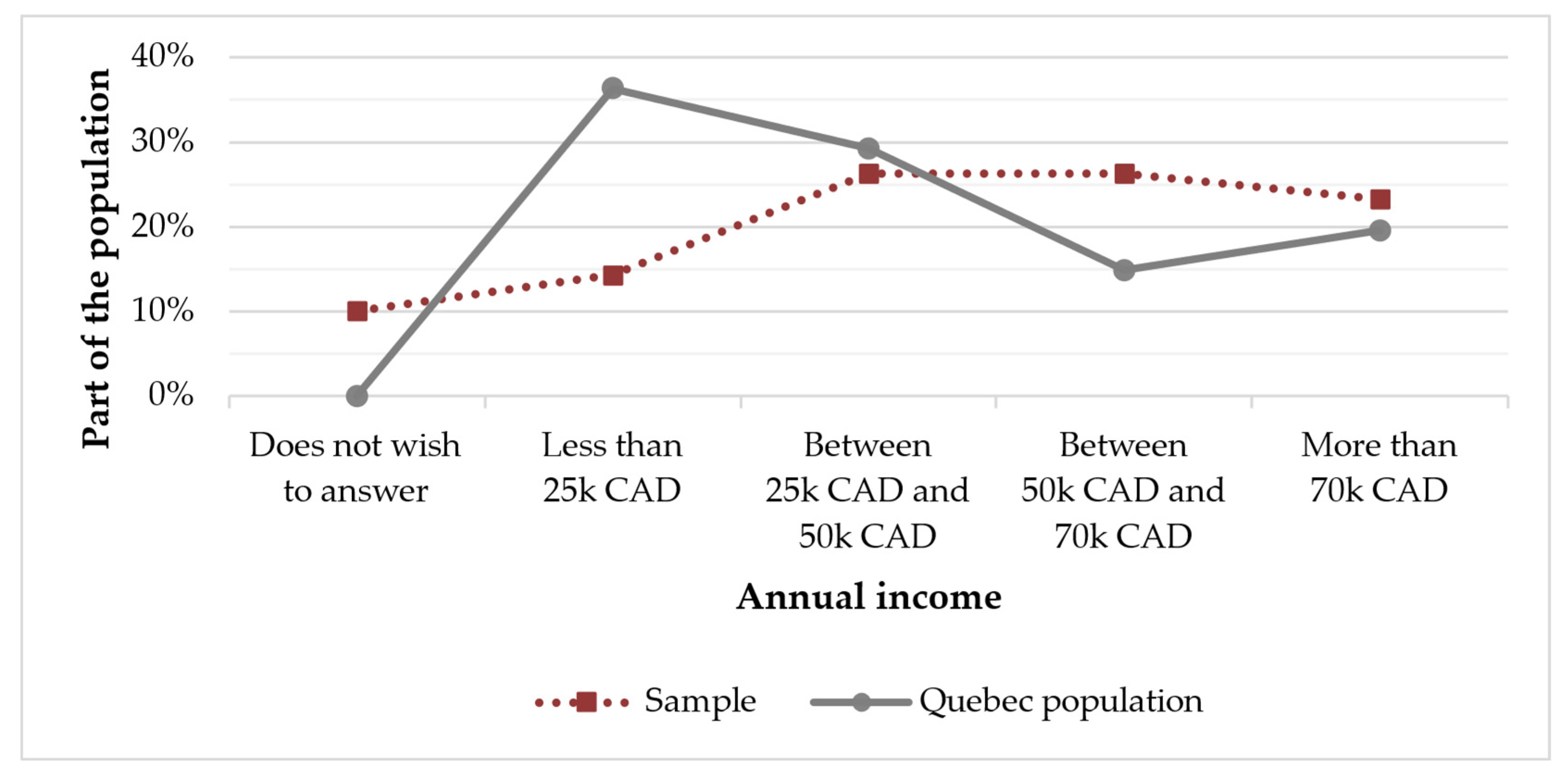
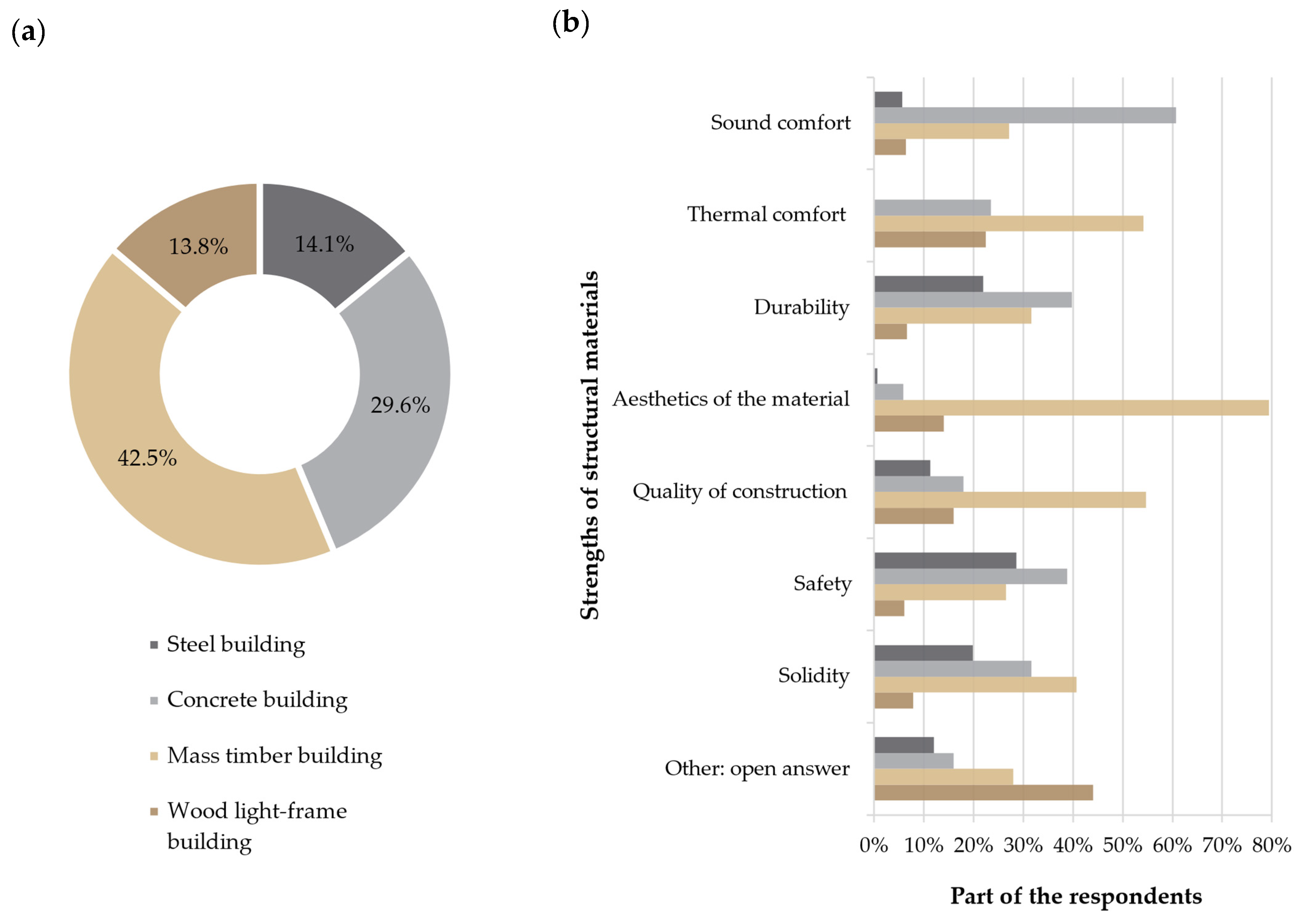
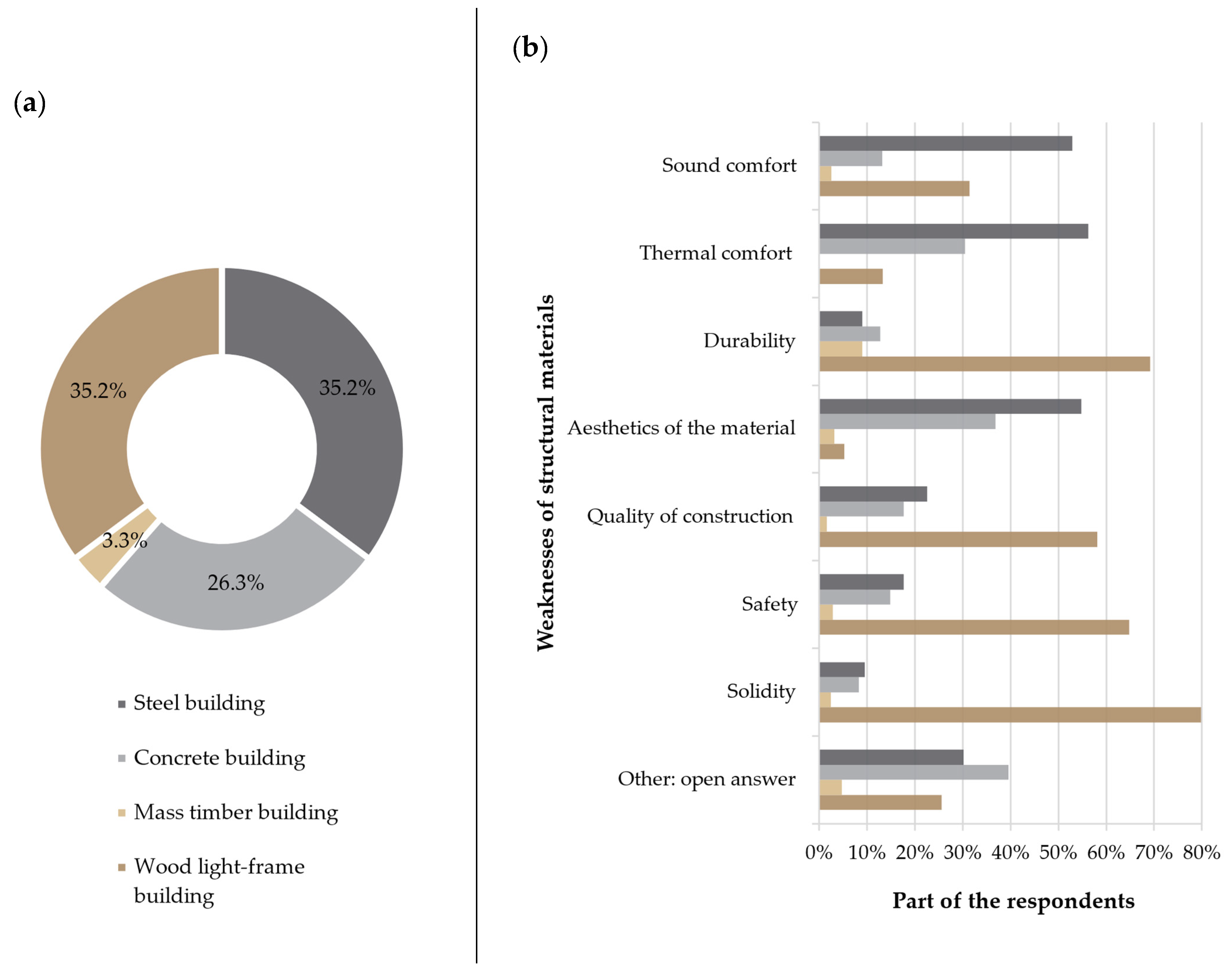

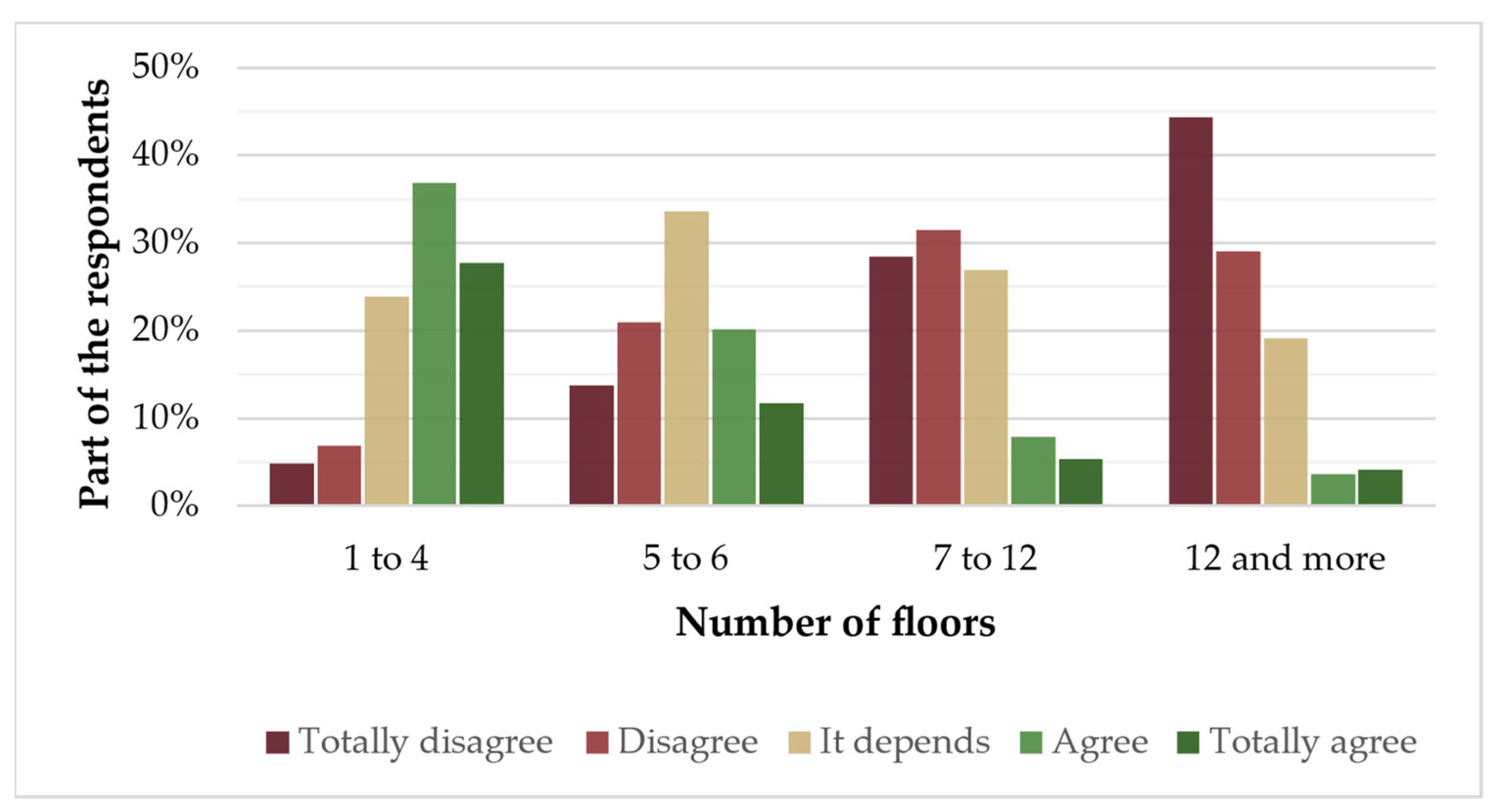

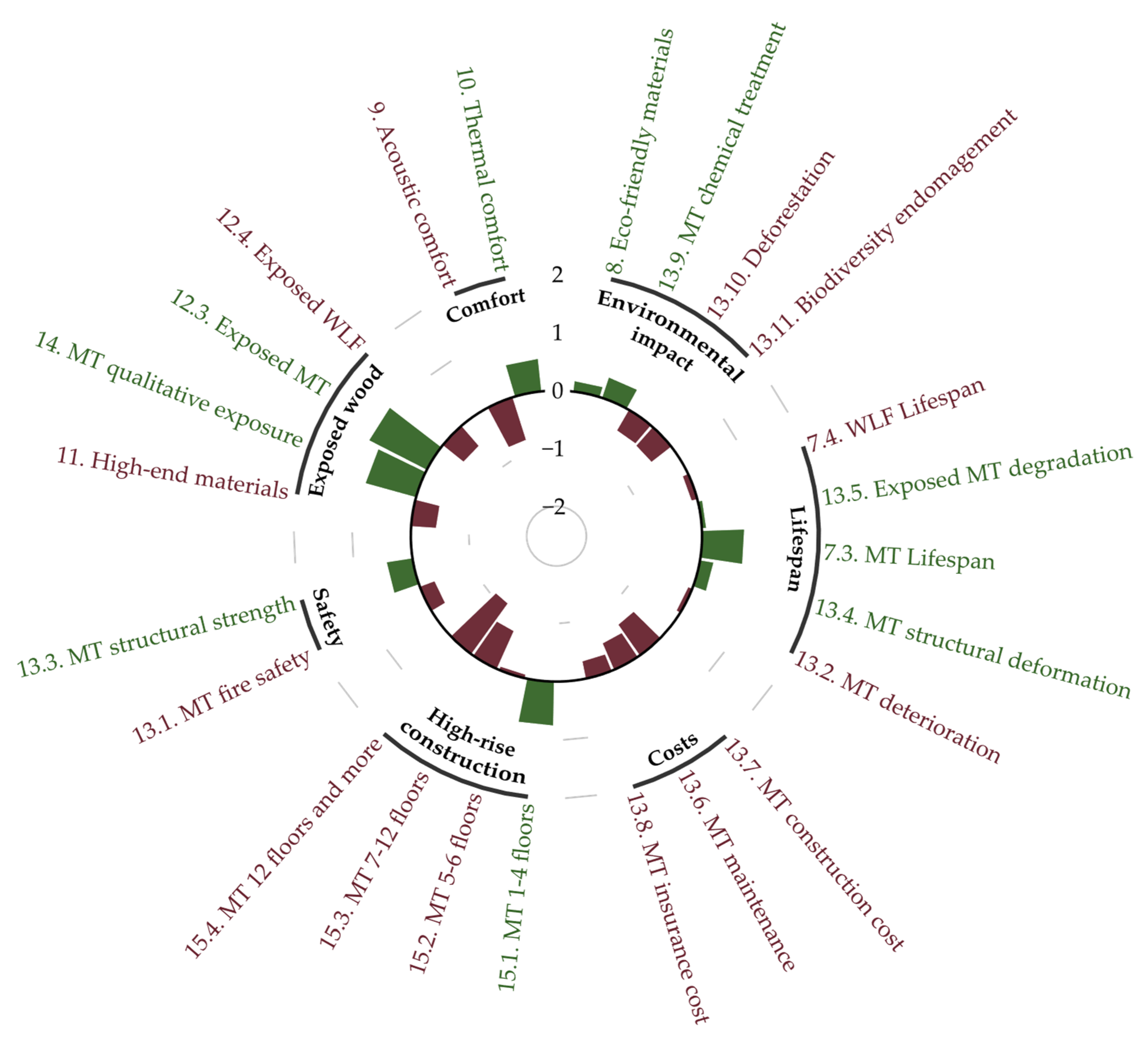
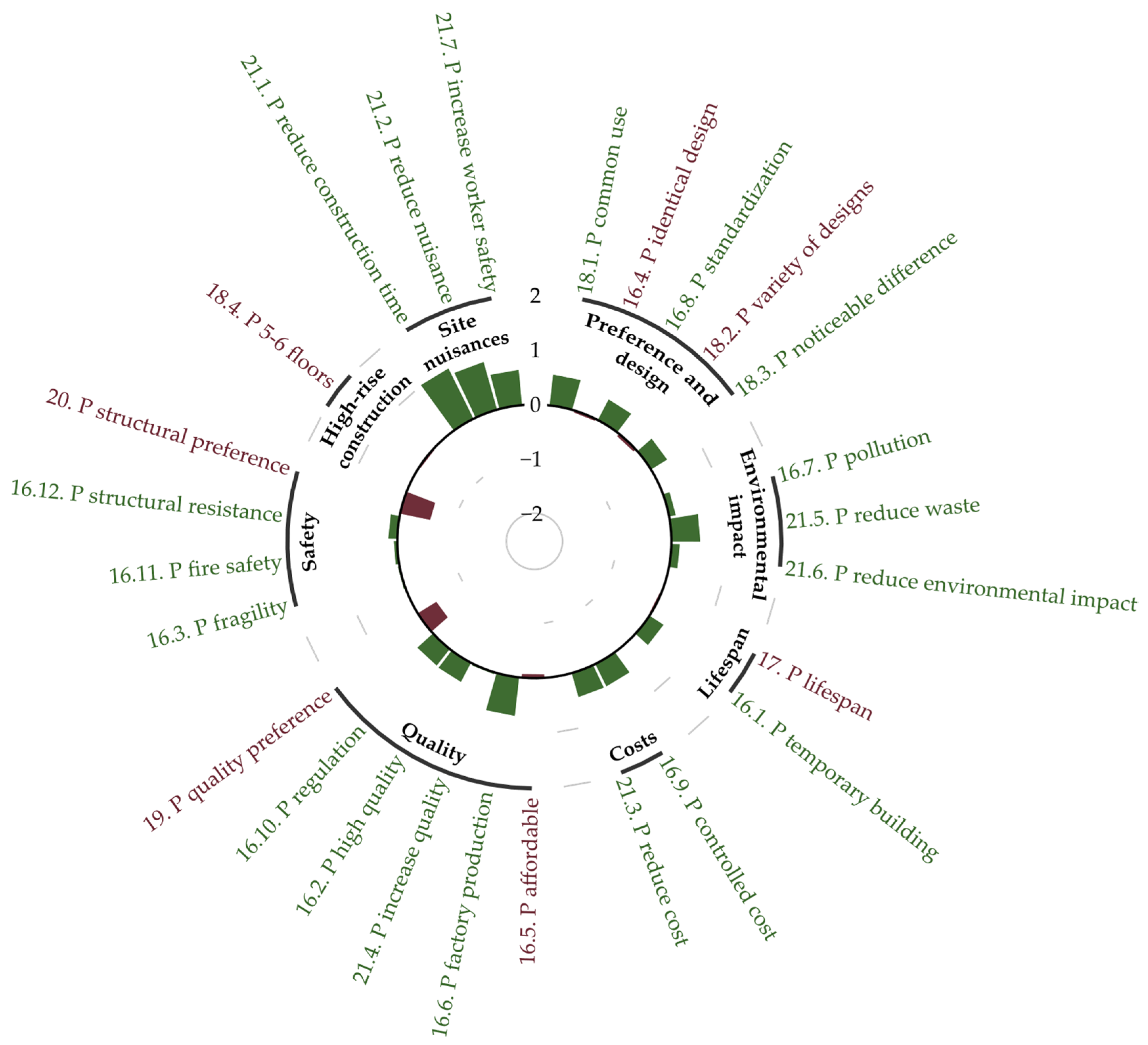
 Group 1: 13.1. MT fire safety—TA; 13.3. MT structural strength—TD; 13.4. MT structural deformation—TD; 13.5. Exposed MT degradation—TD; 13.6. MT maintenance—TD; 13.9. MT chemical treatment—TD; 13.10. Deforestation—TD; 13.11. Biodiversity damage—TD; 15.1. MT 1–4 floors—TA; 15.2. MT 5–6 floors—TA; 15.3. MT 7–12 floors—TA; 15.4. MT 12 floors and more—TA; (Continued from group 1); 16.1. P temporary building—TD; 16.2. P high quality—TA; 16.3. P fragility—TD; 16.4. P identical design—TD; 16.11. P fire safety—TD; 16.12. P structural resistance—TD; 17. P lifespan—100 years or more; 18.2. P variety of designs—TD;
Group 1: 13.1. MT fire safety—TA; 13.3. MT structural strength—TD; 13.4. MT structural deformation—TD; 13.5. Exposed MT degradation—TD; 13.6. MT maintenance—TD; 13.9. MT chemical treatment—TD; 13.10. Deforestation—TD; 13.11. Biodiversity damage—TD; 15.1. MT 1–4 floors—TA; 15.2. MT 5–6 floors—TA; 15.3. MT 7–12 floors—TA; 15.4. MT 12 floors and more—TA; (Continued from group 1); 16.1. P temporary building—TD; 16.2. P high quality—TA; 16.3. P fragility—TD; 16.4. P identical design—TD; 16.11. P fire safety—TD; 16.12. P structural resistance—TD; 17. P lifespan—100 years or more; 18.2. P variety of designs—TD;  Group 2: 13.1. MT fire safety—TD; 13.4. MT structural deformation—TA; 13.5. Exposed MT degradation—TA; 13.6. MT maintenance—TA; 16.1. P temporary building—TA; 16.3. P fragility—TA; 16.4. P identical design—TA; 16.5. P affordable—TA; 16.11. P fire safety—TA; 17. P lifespan—20 years or less; 18.4. P 5–6 floors—TD; 21.7. P increase worker safety—TD; (b) Factorial plane between factors 3 and 4;
Group 2: 13.1. MT fire safety—TD; 13.4. MT structural deformation—TA; 13.5. Exposed MT degradation—TA; 13.6. MT maintenance—TA; 16.1. P temporary building—TA; 16.3. P fragility—TA; 16.4. P identical design—TA; 16.5. P affordable—TA; 16.11. P fire safety—TA; 17. P lifespan—20 years or less; 18.4. P 5–6 floors—TD; 21.7. P increase worker safety—TD; (b) Factorial plane between factors 3 and 4;  Group 3: 13.10. Deforestation—TD; 13.11. Biodiversity damage—TD; 16.4. P identical design—TD; 19. P quality preference—I don’t know; 20. P structural preference—I don’t know; 21.1. P reduce construction time—N; 21.4. P increase quality—A;
Group 3: 13.10. Deforestation—TD; 13.11. Biodiversity damage—TD; 16.4. P identical design—TD; 19. P quality preference—I don’t know; 20. P structural preference—I don’t know; 21.1. P reduce construction time—N; 21.4. P increase quality—A;  Group 4: 7.3. MT Lifespan—100 years and more; 7.4. WLF Lifespan—80 years; 18.2. P variety of designs—TA; 18.4. P 5–6 floors—TD; 21.4. P increase quality—TD; 21.5. P reduce waste—TD; 21.6. P reduce environmental impact—TD; 21.7. P increase worker safety—TD;
Group 4: 7.3. MT Lifespan—100 years and more; 7.4. WLF Lifespan—80 years; 18.2. P variety of designs—TA; 18.4. P 5–6 floors—TD; 21.4. P increase quality—TD; 21.5. P reduce waste—TD; 21.6. P reduce environmental impact—TD; 21.7. P increase worker safety—TD;  Group 5: 7.4. WLF Lifespan—20 years or less; 17. P lifespan—20 years or less; 19. P quality preference—Prefabricated construction; 21.4. P increase quality—TA; 21.5. P reduce waste—TA; 21.6. P reduce environmental impact—TA; 21.7. P increase worker safety—TA.
Group 5: 7.4. WLF Lifespan—20 years or less; 17. P lifespan—20 years or less; 19. P quality preference—Prefabricated construction; 21.4. P increase quality—TA; 21.5. P reduce waste—TA; 21.6. P reduce environmental impact—TA; 21.7. P increase worker safety—TA.
 Group 1: 13.1. MT fire safety—TA; 13.3. MT structural strength—TD; 13.4. MT structural deformation—TD; 13.5. Exposed MT degradation—TD; 13.6. MT maintenance—TD; 13.9. MT chemical treatment—TD; 13.10. Deforestation—TD; 13.11. Biodiversity damage—TD; 15.1. MT 1–4 floors—TA; 15.2. MT 5–6 floors—TA; 15.3. MT 7–12 floors—TA; 15.4. MT 12 floors and more—TA; (Continued from group 1); 16.1. P temporary building—TD; 16.2. P high quality—TA; 16.3. P fragility—TD; 16.4. P identical design—TD; 16.11. P fire safety—TD; 16.12. P structural resistance—TD; 17. P lifespan—100 years or more; 18.2. P variety of designs—TD;
Group 1: 13.1. MT fire safety—TA; 13.3. MT structural strength—TD; 13.4. MT structural deformation—TD; 13.5. Exposed MT degradation—TD; 13.6. MT maintenance—TD; 13.9. MT chemical treatment—TD; 13.10. Deforestation—TD; 13.11. Biodiversity damage—TD; 15.1. MT 1–4 floors—TA; 15.2. MT 5–6 floors—TA; 15.3. MT 7–12 floors—TA; 15.4. MT 12 floors and more—TA; (Continued from group 1); 16.1. P temporary building—TD; 16.2. P high quality—TA; 16.3. P fragility—TD; 16.4. P identical design—TD; 16.11. P fire safety—TD; 16.12. P structural resistance—TD; 17. P lifespan—100 years or more; 18.2. P variety of designs—TD;  Group 2: 13.1. MT fire safety—TD; 13.4. MT structural deformation—TA; 13.5. Exposed MT degradation—TA; 13.6. MT maintenance—TA; 16.1. P temporary building—TA; 16.3. P fragility—TA; 16.4. P identical design—TA; 16.5. P affordable—TA; 16.11. P fire safety—TA; 17. P lifespan—20 years or less; 18.4. P 5–6 floors—TD; 21.7. P increase worker safety—TD; (b) Factorial plane between factors 3 and 4;
Group 2: 13.1. MT fire safety—TD; 13.4. MT structural deformation—TA; 13.5. Exposed MT degradation—TA; 13.6. MT maintenance—TA; 16.1. P temporary building—TA; 16.3. P fragility—TA; 16.4. P identical design—TA; 16.5. P affordable—TA; 16.11. P fire safety—TA; 17. P lifespan—20 years or less; 18.4. P 5–6 floors—TD; 21.7. P increase worker safety—TD; (b) Factorial plane between factors 3 and 4;  Group 3: 13.10. Deforestation—TD; 13.11. Biodiversity damage—TD; 16.4. P identical design—TD; 19. P quality preference—I don’t know; 20. P structural preference—I don’t know; 21.1. P reduce construction time—N; 21.4. P increase quality—A;
Group 3: 13.10. Deforestation—TD; 13.11. Biodiversity damage—TD; 16.4. P identical design—TD; 19. P quality preference—I don’t know; 20. P structural preference—I don’t know; 21.1. P reduce construction time—N; 21.4. P increase quality—A;  Group 4: 7.3. MT Lifespan—100 years and more; 7.4. WLF Lifespan—80 years; 18.2. P variety of designs—TA; 18.4. P 5–6 floors—TD; 21.4. P increase quality—TD; 21.5. P reduce waste—TD; 21.6. P reduce environmental impact—TD; 21.7. P increase worker safety—TD;
Group 4: 7.3. MT Lifespan—100 years and more; 7.4. WLF Lifespan—80 years; 18.2. P variety of designs—TA; 18.4. P 5–6 floors—TD; 21.4. P increase quality—TD; 21.5. P reduce waste—TD; 21.6. P reduce environmental impact—TD; 21.7. P increase worker safety—TD;  Group 5: 7.4. WLF Lifespan—20 years or less; 17. P lifespan—20 years or less; 19. P quality preference—Prefabricated construction; 21.4. P increase quality—TA; 21.5. P reduce waste—TA; 21.6. P reduce environmental impact—TA; 21.7. P increase worker safety—TA.
Group 5: 7.4. WLF Lifespan—20 years or less; 17. P lifespan—20 years or less; 19. P quality preference—Prefabricated construction; 21.4. P increase quality—TA; 21.5. P reduce waste—TA; 21.6. P reduce environmental impact—TA; 21.7. P increase worker safety—TA.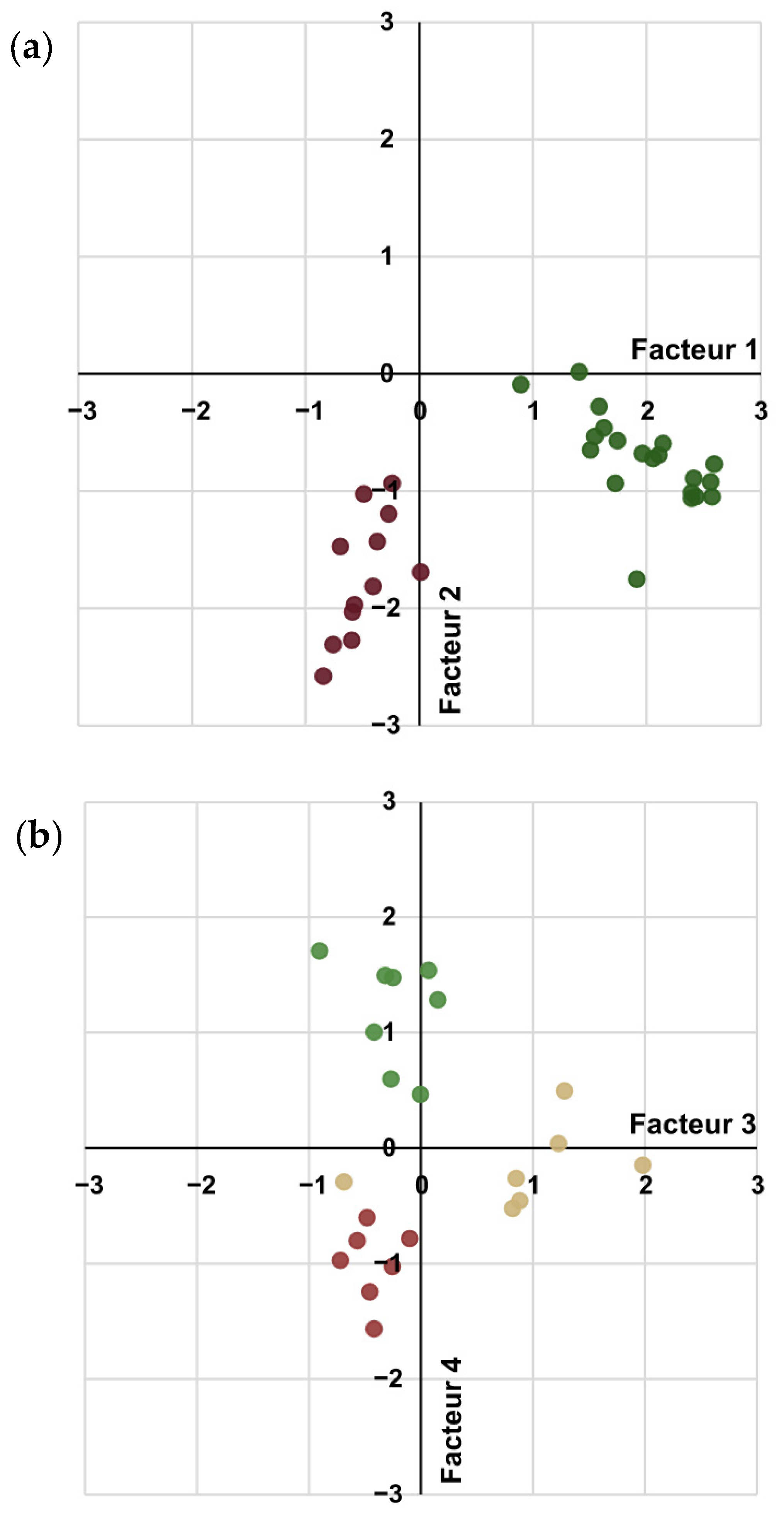
| Woodlight-frame | Lifespan | 7.4. WLF Lifespan | |||||||||||||
| Exposed wood | 12.4. Exposed WLF | X | |||||||||||||
| Preferences | 5/6. Building preference - WLF | ||||||||||||||
| Mass timber | 5/6. building preference - MT | ||||||||||||||
| High-rise construction | 15.4. MT 12 floors and more | ||||||||||||||
| 15.3. MT 7-12 floors | |||||||||||||||
| 15.2. MT 5-6 floors | X | ||||||||||||||
| 15.1. MT 1-4 floors | X | ||||||||||||||
| Safety | 13.3. MT structural strength | X | X | X | |||||||||||
| 13.1. MT fire safety | X | ||||||||||||||
| Costs | 13.8. MT insurance cost | ||||||||||||||
| 13.6. MT maintenance | |||||||||||||||
| 13.7. MT construction cost | X | X | |||||||||||||
| Lifespan | 13.2. MT deterioration | X | |||||||||||||
| 13.4. MT structural deformation | X | ||||||||||||||
| 7.3. MT Lifespan | X | ||||||||||||||
| Exposed wood | 13.5. Exposed MT degradation | X | |||||||||||||
| 12.3. Exposed MT | |||||||||||||||
| 14. MT qualitative exposure | X | ||||||||||||||
| Wooden construction methods (MT and WLF) | 11. High-end materials - WLF | ||||||||||||||
| 11. High-end materials - MT | |||||||||||||||
| Comfort | 10. Thermal comfort | ||||||||||||||
| 9. Acoustic comfort | |||||||||||||||
| Environmentalimpact | 13.11. Biodiversity damage | ||||||||||||||
| 13.10. Deforestation | |||||||||||||||
| 13.9. MT chemical treatment | X | ||||||||||||||
| 8. Eco-friendly materials - WLF | |||||||||||||||
| 8. Eco-friendly materials - MT | |||||||||||||||
| Subject | Variable wording | Inhabitants ofsteel buildings | Inhabitants ofconcrete buildings | Inhabitants ofmass timber buildings | Inhabitants of light-frame wood buildings | Inhabitants who do not know the construction method | Men | Women | 18 to 24 years old | 25 to 34 years old | 35 to 44 years old | 45 to 54 years old | 55 to 65 years old | Over 65 years old | |
| Type of structure of the occupied building | Gender | Age | |||||||||||||
| Light-frame wood prefabrication | Advantage related to the construction site | 21.7. P increase worker safety | |||||||||||||
| 21.2. P reduce nuisance | X | ||||||||||||||
| 21.1. P reduce construction time | X | X | X | ||||||||||||
| High-rise construction | 18.4. P 5-6 floors | X | |||||||||||||
| Safety | 20. P structural preference | X | X | X | X | X | X | ||||||||
| 16.12. P structural strength | X | X | |||||||||||||
| 16.11. P fire safety | X | ||||||||||||||
| 16.3. P fragility | |||||||||||||||
| Quality | 19. P quality preference | X | X | ||||||||||||
| 16.10. P regulation | X | X | |||||||||||||
| 16.2. P high quality | X | X | |||||||||||||
| 21.4. P increase quality | X | ||||||||||||||
| 16.6. P factory production | |||||||||||||||
| 16.5. P affordable | X | X | X | ||||||||||||
| Costs | 21.3. P reduce cost | ||||||||||||||
| 16.9. P controlled cost | |||||||||||||||
| Lifespan | 16.1. P temporary building | ||||||||||||||
| 17. P lifespan | |||||||||||||||
| Environmental impact | 21.6. P reduce environmental impact | X | X | ||||||||||||
| 21.5. P reduce waste | X | ||||||||||||||
| 16.7. P pollution | |||||||||||||||
| Preference anddesign | 18.3. P noticeable difference | X | |||||||||||||
| 18.2. P variety of designs | X | X | |||||||||||||
| 16.8. P standardisation | X | X | |||||||||||||
| 16.4. P identical design | X | ||||||||||||||
| 18.1. P common use | X | X | |||||||||||||
| Subject | Variable wording | Inhabitants of steel buildings | Inhabitants of concrete buildings | Inhabitants of mass timber buildings | Inhabitants of light-frame wood buildings | Inhabitants who do not know the construction method | Men | Women | 18 to 24 years old | 25 to 34 years old | 35 to 44 years old | 45 to 54 years old | 55 to 65 years old | Over 65 years old | |
| Type of structure of the occupied building | Gender | Age | |||||||||||||
Publisher’s Note: MDPI stays neutral with regard to jurisdictional claims in published maps and institutional affiliations. |
© 2022 by the authors. Licensee MDPI, Basel, Switzerland. This article is an open access article distributed under the terms and conditions of the Creative Commons Attribution (CC BY) license (https://creativecommons.org/licenses/by/4.0/).
Share and Cite
Giorgio, B.; Blanchet, P.; Barlet, A. Social Representations of Mass Timber and Prefabricated Light-Frame Wood Construction for Multi-Story Housing: The Vision of Users in Quebec. Buildings 2022, 12, 2073. https://doi.org/10.3390/buildings12122073
Giorgio B, Blanchet P, Barlet A. Social Representations of Mass Timber and Prefabricated Light-Frame Wood Construction for Multi-Story Housing: The Vision of Users in Quebec. Buildings. 2022; 12(12):2073. https://doi.org/10.3390/buildings12122073
Chicago/Turabian StyleGiorgio, Baptiste, Pierre Blanchet, and Aline Barlet. 2022. "Social Representations of Mass Timber and Prefabricated Light-Frame Wood Construction for Multi-Story Housing: The Vision of Users in Quebec" Buildings 12, no. 12: 2073. https://doi.org/10.3390/buildings12122073
APA StyleGiorgio, B., Blanchet, P., & Barlet, A. (2022). Social Representations of Mass Timber and Prefabricated Light-Frame Wood Construction for Multi-Story Housing: The Vision of Users in Quebec. Buildings, 12(12), 2073. https://doi.org/10.3390/buildings12122073






